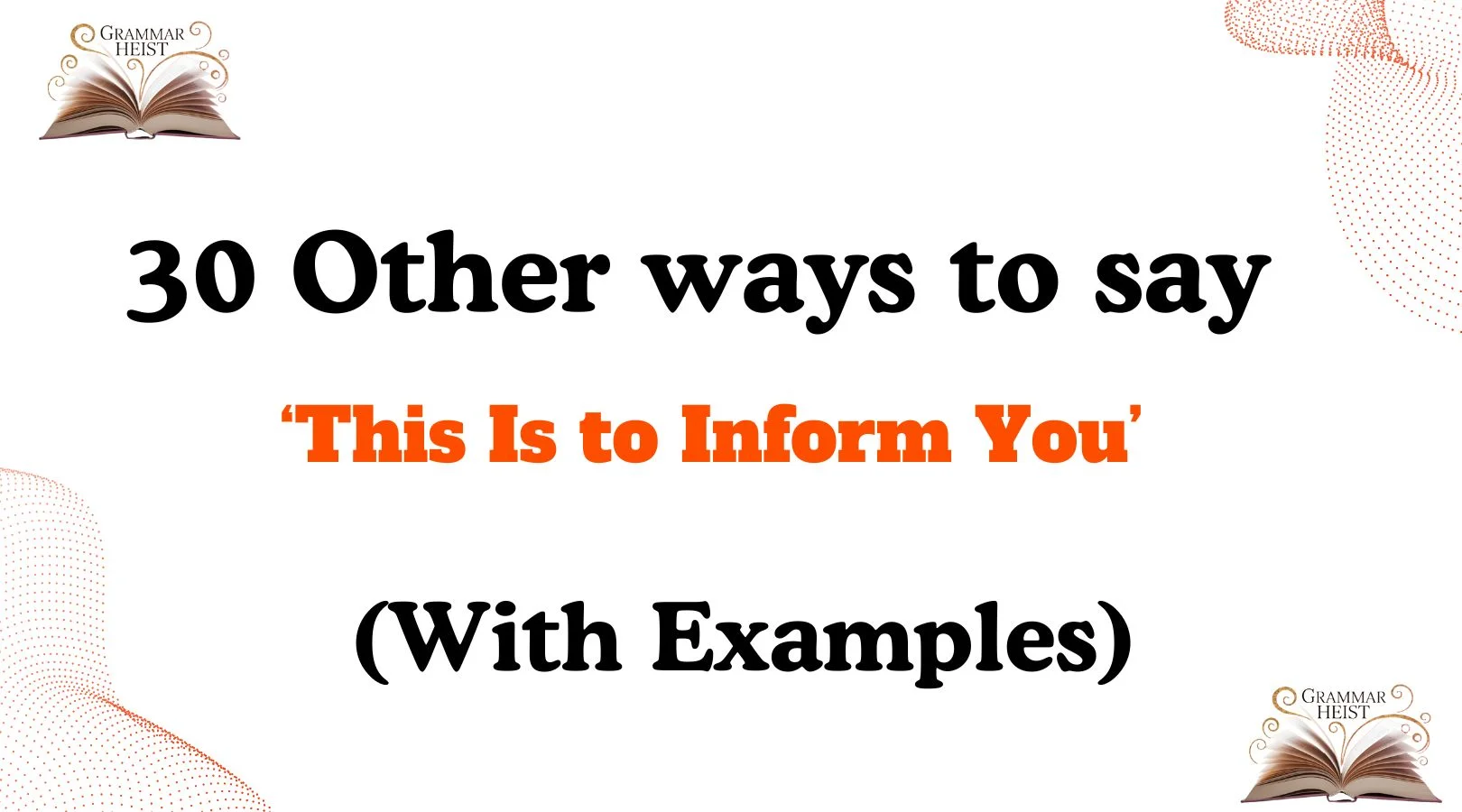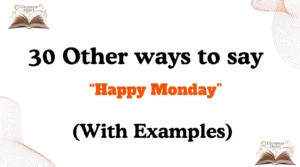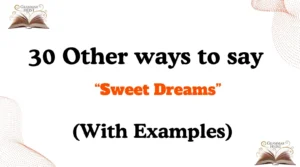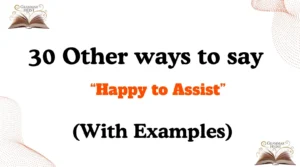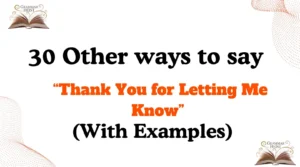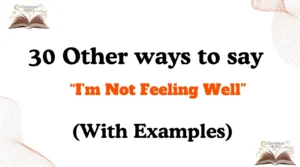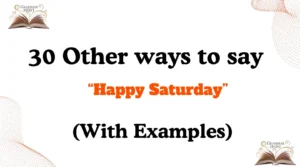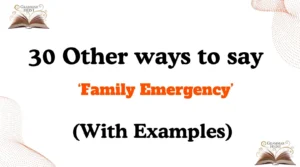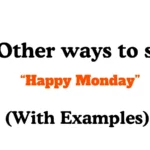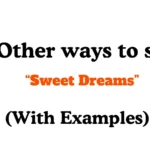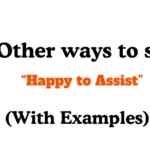Finding the right words can completely transform the way your message is received. While “this is to inform you” is clear and direct, it can sometimes sound too formal, distant, or even impersonal. If you want to show empathy, warmth, and thoughtfulness, there are many alternatives you can use. These options allow you to communicate the same meaning in a way that feels caring, approachable, and respectful.
Below, you’ll find 30 alternatives, each explained with scenarios, examples, tone, and guidance so you can choose the one that best fits your situation.
What Does “This Is to Inform You” Mean?
The phrase “this is to inform you” is typically used in professional or official communication to announce, notify, or deliver information. It’s common in emails, letters, and notices where clarity and formality are required.
Is It Professional/Polite to Say “This Is to Inform You”?
Yes, it’s professional, but it can sound cold or overly formal depending on the context. In customer service, personal updates, or sensitive matters, softer alternatives often leave a better impression.
Pros or Cons of Using “This Is to Inform You”
Pros:
- Direct and unambiguous
- Professional tone
- Universally understood
Cons:
- Can feel impersonal or robotic
- Lacks warmth and empathy
- May create emotional distance in sensitive situations
Synonyms For “This Is to Inform You”
- I’d Like to Let You Know
- Just a Quick Note to Say
- Please Be Aware
- I Wanted to Share
- Kindly Note
- I’m Reaching Out to Let You Know
- I’d Like to Inform You
- I Wanted to Update You
- For Your Awareness
- I’d Like to Notify You
- Here’s an Update
- I’m Writing to Let You Know
- Just Wanted to Let You Know
- I’d Like to Bring to Your Attention
- Please Take Note
- Allow Me to Inform You
- You Should Know
- This Is Just a Heads-Up
- Please Note That
- I’d Like to Make You Aware
- Please Allow Me to Share
- I’m Happy to Let You Know
- I’d Like to Draw Your Attention To
- As a Reminder
- This Is Just to Notify You
- Please Keep in Mind
- I’d Like to Bring to Your Notice
- I’d Like to Advise You
- For Your Reference
- This Message Is to Notify You
1. I’d Like to Let You Know
Scenario: Friendly but professional updates in emails or conversations.
Examples:
- I’d like to let you know that your application has been successfully submitted.
- I’d like to let you know that our office hours will be changing next week.
- I’d like to let you know how much we value your continued support.
Tone: Warm, polite, and approachable.
Explanation: This softens the directness, making it more personal.
2. Just a Quick Note to Say
Scenario: Informal updates, customer service messages, or casual communication.
Examples:
- Just a quick note to say we’ve processed your refund.
- Just a quick note to say your request has been approved.
- Just a quick note to say thanks for your patience.
Tone: Friendly and conversational.
Explanation: Ideal for keeping communication short and light.
3. Please Be Aware
Scenario: Formal notices or policies that require attention.
Examples:
- Please be aware that maintenance will occur this Friday.
- Please be aware your password will expire in three days.
- Please be aware of the updated safety regulations.
Tone: Polite but firm.
Explanation: Retains professionalism while avoiding stiffness.
4. I Wanted to Share
Scenario: Personal updates, team announcements, or casual notes.
Examples:
- I wanted to share the great news about our team’s success.
- I wanted to share that the project deadline has been extended.
- I wanted to share a reminder for tomorrow’s meeting.
Tone: Friendly, open, and inviting.
Explanation: Creates inclusivity and warmth.
5. Kindly Note
Scenario: Professional reminders or policy-related updates.
Examples:
- Kindly note that the meeting has been rescheduled.
- Kindly note your subscription will renew automatically.
- Kindly note the attached form must be signed.
Tone: Respectful and professional.
Explanation: Adds politeness while keeping authority intact.
6. I’m Reaching Out to Let You Know
Scenario: Professional yet caring messages.
Examples:
- I’m reaching out to let you know we’ve received your request.
- I’m reaching out to let you know about some exciting opportunities.
- I’m reaching out to let you know we’re here to help if you need support.
Tone: Warm and proactive.
Explanation: Good for one-to-one messages.
7. I’d Like to Inform You
Scenario: Professional contexts where formality is still required.
Examples:
- I’d like to inform you that your order has been shipped.
- I’d like to inform you of our updated policy.
- I’d like to inform you that your interview is confirmed.
Tone: Polite yet straightforward.
Explanation: Softer than the original phrase but still formal.
8. I Wanted to Update You
Scenario: Progress reports, customer updates, or team communication.
Examples:
- I wanted to update you about the status of your order.
- I wanted to update you on the recent project changes.
- I wanted to update you about our upcoming event.
Tone: Helpful and proactive.
Explanation: Shows you care about keeping someone informed.
9. For Your Awareness
Scenario: Notices, compliance emails, or informational messages.
Examples:
- For your awareness, the system will be offline tomorrow.
- For your awareness, we’ve updated the privacy policy.
- For your awareness, your training session is scheduled.
Tone: Neutral and factual.
Explanation: Good for internal communication.
10. I’d Like to Notify You
Scenario: More official announcements.
Examples:
- I’d like to notify you that your membership has been renewed.
- I’d like to notify you of a change in your account.
- I’d like to notify you about tomorrow’s workshop.
Tone: Polite and formal.
Explanation: Works well in administrative communication.
11. Here’s an Update
Scenario: Informal but respectful, often in emails.
Examples:
- Here’s an update on the delivery schedule.
- Here’s an update about your case.
- Here’s an update on the policy changes.
Tone: Straightforward, simple.
Explanation: Easy to use in casual or professional contexts.
12. I’m Writing to Let You Know
Scenario: Formal emails or letters.
Examples:
- I’m writing to let you know that your application was successful.
- I’m writing to let you know about our revised guidelines.
- I’m writing to let you know we’ve received your documents.
Tone: Professional but personal.
Explanation: Classic alternative for letters and email openings.
13. Just Wanted to Let You Know
Scenario: Casual conversations, lighter updates.
Examples:
- Just wanted to let you know your report looks great.
- Just wanted to let you know I’ll be out tomorrow.
- Just wanted to let you know the meeting is canceled.
Tone: Relaxed, informal.
Explanation: Best for friendly work relationships.
14. I’d Like to Bring to Your Attention
Scenario: Professional, important updates or warnings.
Examples:
- I’d like to bring to your attention an error in the report.
- I’d like to bring to your attention that we’ll need more resources.
- I’d like to bring to your attention new compliance requirements.
Tone: Formal and serious.
Explanation: Highlights importance.
15. Please Take Note
Scenario: Polite reminders.
Examples:
- Please take note of the new deadline.
- Please take note that our policy has changed.
- Please take note of the updated contact details.
Tone: Respectful, clear.
Explanation: Direct without sounding harsh.
16. Allow Me to Inform You
Scenario: Formal or diplomatic communication.
Examples:
- Allow me to inform you that the contract has been signed.
- Allow me to inform you that we’re moving to a new location.
- Allow me to inform you your feedback has been noted.
Tone: Elegant and respectful.
Explanation: Polished for high-level correspondence.
17. You Should Know
Scenario: Casual reminders or team communication.
Examples:
- You should know that the meeting is at 3 PM.
- You should know we’re switching vendors.
- You should know I’ll be traveling next week.
Tone: Informal, straightforward.
Explanation: Friendly but not for formal writing.
18. This Is Just a Heads-Up
Scenario: Light, casual communication.
Examples:
- This is just a heads-up about tomorrow’s event.
- This is just a heads-up that your report is due.
- This is just a heads-up about potential delays.
Tone: Friendly, non-threatening.
Explanation: Keeps things lighthearted.
19. Please Note That
Scenario: Professional reminders or notices.
Examples:
- Please note that your payment is due.
- Please note that we’ll be closed on Monday.
- Please note that the meeting has been postponed.
Tone: Polite, clear, professional.
Explanation: A softer version of formal notices.
20. I’d Like to Make You Aware
Scenario: Business, HR, or compliance updates.
Examples:
- I’d like to make you aware of some upcoming changes.
- I’d like to make you aware of our new procedures.
- I’d like to make you aware that your account is expiring.
Tone: Professional, empathetic.
Explanation: Acknowledges the other person’s importance.
21. Please Allow Me to Share
Scenario: Positive updates or invitations.
Examples:
- Please allow me to share the results of the survey.
- Please allow me to share exciting news about our project.
- Please allow me to share our appreciation for your efforts.
Tone: Warm and inviting.
Explanation: Creates a sense of respect and collaboration.
22. I’m Happy to Let You Know
Scenario: Delivering good news.
Examples:
- I’m happy to let you know that you’ve been selected.
- I’m happy to let you know the issue has been resolved.
- I’m happy to let you know your proposal was approved.
Tone: Positive, uplifting.
Explanation: Best when sharing good outcomes.
23. I’d Like to Draw Your Attention To
Scenario: Professional corrections or important notices.
Examples:
- I’d like to draw your attention to the new schedule.
- I’d like to draw your attention to discrepancies in the file.
- I’d like to draw your attention to recent updates.
Tone: Formal, serious.
Explanation: Direct but respectful.
24. As a Reminder
Scenario: Gentle reminders.
Examples:
- As a reminder, the meeting starts at 9 AM.
- As a reminder, invoices are due Friday.
- As a reminder, please update your contact info.
Tone: Polite and helpful.
Explanation: Keeps things professional yet light.
25. This Is Just to Notify You
Scenario: Neutral updates.
Examples:
- This is just to notify you of system downtime.
- This is just to notify you of a new office rule.
- This is just to notify you that your request has been logged.
Tone: Formal but gentle.
Explanation: Clear without being too harsh.
26. Please Keep in Mind
Scenario: Helpful reminders.
Examples:
- Please keep in mind the new submission deadline.
- Please keep in mind our office will close early.
- Please keep in mind the terms have changed.
Tone: Caring and thoughtful.
Explanation: Suggests concern for the recipient.
27. I’d Like to Bring to Your Notice
Scenario: Formal written communication.
Examples:
- I’d like to bring to your notice an important update.
- I’d like to bring to your notice changes in procedures.
- I’d like to bring to your notice the results of the review.
Tone: Formal and official.
Explanation: Useful in administrative contexts.
28. I’d Like to Advise You
Scenario: Professional advisory communication.
Examples:
- I’d like to advise you that the deadline has moved.
- I’d like to advise you about the new requirements.
- I’d like to advise you regarding your account.
Tone: Formal and advisory.
Explanation: Shows authority with politeness.
29. For Your Reference
Scenario: Sharing additional documents or details.
Examples:
- For your reference, I’ve attached the full report.
- For your reference, here is the updated policy.
- For your reference, you can view the schedule online.
Tone: Helpful and professional.
Explanation: Common in written communication.
30. This Message Is to Notify You
Scenario: Official announcements.
Examples:
- This message is to notify you about upcoming changes.
- This message is to notify you of your account renewal.
- This message is to notify you regarding your results.
Tone: Neutral, official.
Explanation: Keeps the essence of the original phrase but softens it.
Conclusion
Using thoughtful alternatives to “this is to inform you” helps create messages that are not only clear but also empathetic and approachable. Whether you’re writing in a professional context or simply want to show care in your communication, these 30 alternatives give you flexibility to adapt your tone to the situation.

Emma Rose is a dedicated writing expert with a passion for helping others enhance their communication skills. With a strong background in grammar, language structure, and style, Emma empowers individuals to write with clarity, confidence, and impact. Her approach combines a keen attention to detail with a supportive, personalized touch, ensuring each person she works with improves and grows in their writing journey.
